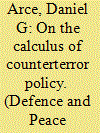| Srl | Item |
| 1 |
ID:
172141


|
|
|
|
|
| Summary/Abstract |
In democratic societies, elections can act as a referendum on politicians’ counterterror policy. At the same time, counterterror policy is conducted under conditions of asymmetric information because the government is better informed about the nature of the threat than is the public. Using a hybrid signaling model, this paper characterizes counterterror policy in terms of its instrumental efficacy against terrorists, and also non-instrumental considerations such as the electoral consequences of policy failures. In addition, the equilibria capture the difficulties that voters have in assessing the appropriateness of policy in the absence of terrorism.
|
|
|
|
|
|
|
|
|
|
|
|
|
|
|
|
| 2 |
ID:
109908


|
|
|
|
|
| Publication |
2012.
|
| Summary/Abstract |
Using the most comprehensive weekly dataset of 'A' shares listed on the Chinese stock market, this paper examines short-term contrarian strategies under different market states from 1995-2010. We find statistically significant profits from contrarian strategies, especially during the period after 2007, when China (along with other countries) experienced an economic downturn following the worldwide financial crisis. Our empirical evidence suggests that: (1) no significant profit is generated from either momentum or contrarian strategies in the intermediate horizon; (2) after microstructure effects are adjusted for, contrarian strategies with only four to eight weeks holding periods based on the stocks' previous four to eight week's performance generate statistically significant profits of around 0.2% per week; (3) the contrarian strategy following a 'down' market generates higher profit than those following an 'up' market, suggesting that a contrarian strategy could be used as a shelter when the market is in decline. The profits following a 'down' market are robust after risk adjustment.
|
|
|
|
|
|
|
|
|
|
|
|
|
|
|
|